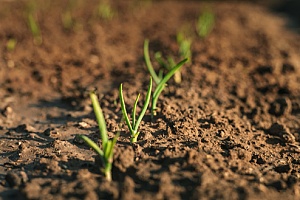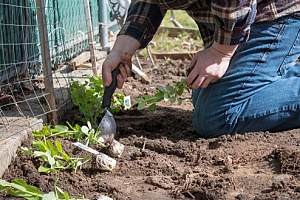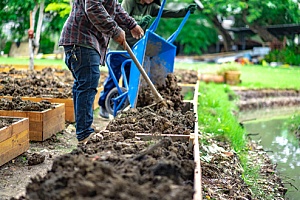 Garden soil may look like it is comprised of just dirt, but it is actually a complex mixture containing organic material, mineral particles, living organisms, chemical nutrients and moisture. Every soil is different, and its precise texture, which is determined by the size of its mineral particles, plays a significant role in its ability to grow plants.
Garden soil may look like it is comprised of just dirt, but it is actually a complex mixture containing organic material, mineral particles, living organisms, chemical nutrients and moisture. Every soil is different, and its precise texture, which is determined by the size of its mineral particles, plays a significant role in its ability to grow plants.
The best type of soil for gardening is loamy soil, which contains a mixture of sand, intermediate mineral particles, clay and organic material. Unfortunately, much of the soil found in the United States tends to be clay soil. Although some types of trees and shrubs will grow well in clay soil, vegetables, annuals and perennials do not fare well in this type of soil as their roots are not strong enough to make their way through dense clay.
The good news is that it is possible to improve clay soil on your own to make it more suited to growing flowers and vegetables. Here is a look at what clay soil is and how you can improve it to foster plant growth.
What Is Clay Soil?
Clay soil is made up of very fine mineral particles and does not contain much organic material. This is a very sticky type of soil due to the lack of space between mineral particles. If water generally puddles on the ground instead of soaking in, you may well have clay soil, which is known for its inability to drain well. Soil that contains more than 50% clay particles is considered heavy clay.
If your soil tends to stick to your gardening tools and shoes like glue, if it can form into large cakes that are difficult to separate, and if it crusts over in dry weather, then there is a good chance that it is clay.
The Pros Of Clay Soil
 Although it is inhospitable to growing certain types of plants, clay soil has several benefits. Its density means that it is able to hold on to moisture well. It also tends to have more nutrients than other types of soil because its negatively charged particles can attract and hold the positively charged particles found in magnesium, potassium and calcium.
Although it is inhospitable to growing certain types of plants, clay soil has several benefits. Its density means that it is able to hold on to moisture well. It also tends to have more nutrients than other types of soil because its negatively charged particles can attract and hold the positively charged particles found in magnesium, potassium and calcium.
The Cons Of Clay Soil
However, in addition to being slow to drain, clay soil tends to be alkaline in pH, which means that some types of plants will struggle to grow in it. It is also slow to warm up in the spring, and the fact that it compacts easily means plant roots sometimes struggle to grow.
Steps For Improving Clay Soil
Although improving clay soil requires some work, it can have a dramatic effect rather quickly. You only need to do most of this work once, and it is best to improve the entire planting area instead of tackling individual planting holes as needed.
Define Your Growing Area
First, you need to define the growing area of your garden bed. If you have plants that are currently growing there, you should dig them out and set them aside in temporary pots until your work is finished.
Add Organic Material
Experts recommend adding 6 to 8 inches of organic matter to your garden bed to improve clay soil. Some of the organic matter you can use includes shredded leaves, compost, rotted manure and grass clippings that have not been treated using chemicals. You will want to spread this organic matter across the entire surface area of the soil.
Mix The Organic Matter Into The Soil
 Next, you need to mix the organic matter into the top 6 to 12 inches of your soil. If your garden bed is relatively small, you can simply dig it in and mix it using a shovel as this will move a lot of dirt without damaging the soil particles the way that tilling might.
Next, you need to mix the organic matter into the top 6 to 12 inches of your soil. If your garden bed is relatively small, you can simply dig it in and mix it using a shovel as this will move a lot of dirt without damaging the soil particles the way that tilling might.
Some people find that digging is tough on their joints or back. In these cases, a tiller can be used to gently work the organic matter in. Because tilling can sometimes cause soil compaction, make sure you begin with soil that is slightly moist for the best results.
You will notice that your garden bed is significantly higher than it was before you began, but keep in mind that it will settle throughout the season as the organic material you have added to it begins to break down. As it breaks down, it will improve the soil structure.
Start Planting
You can begin planting in your garden bed right away if the season is right. If not, consider planting cover crops to help incorporate your soil amendments deeper into the clay by rooting downward. Look for a cover crop that is suitable for your area and climate, keeping in mind that some cover crops will die in cold temperatures in the winter, which reduces the prep work needed when it is time to plant in the spring.
Avoid Walking In Your Garden Beds
 After going through the time and effort involved in improving your clay soil, you want to ensure it stays in optimum condition. A big part of this is avoiding compaction, which means you should not walk in your garden bed. It is a good idea to create garden beds that are narrow enough that you do not need to walk in them to reach all sides.
After going through the time and effort involved in improving your clay soil, you want to ensure it stays in optimum condition. A big part of this is avoiding compaction, which means you should not walk in your garden bed. It is a good idea to create garden beds that are narrow enough that you do not need to walk in them to reach all sides.
Stay On Top Of Maintenance
Once the main work is done, your soil will enjoy long-term improvements. However, you will need to add some more organic matter to it in the form of compost once or twice a year to offset any settling that may occur and continue improving the structure of the soil. From time to time, you might consider having a sample of your soil tested to determine whether it has any pH issues or nutrient deficiencies. The results will usually come with a report that offers recommendations for further improvements that you can make to your garden.
Get In Touch With Dirt Connections</h2?
Dirt Connections offers a comprehensive range of residential and commercial dirt, driveway and construction services in the Northern Virginia area. Get in touch today to find out more about the right type of soil for your gardening projects.
Summary

Dirt Connections was started with one goal in mind: providing quality residential and commercial construction services to clients on time and on budget. Reach out for more information on how we can support your next project.
For your convenience our estimates are free and by appointment. Call 703-940-9949 for a free estimate today!









































